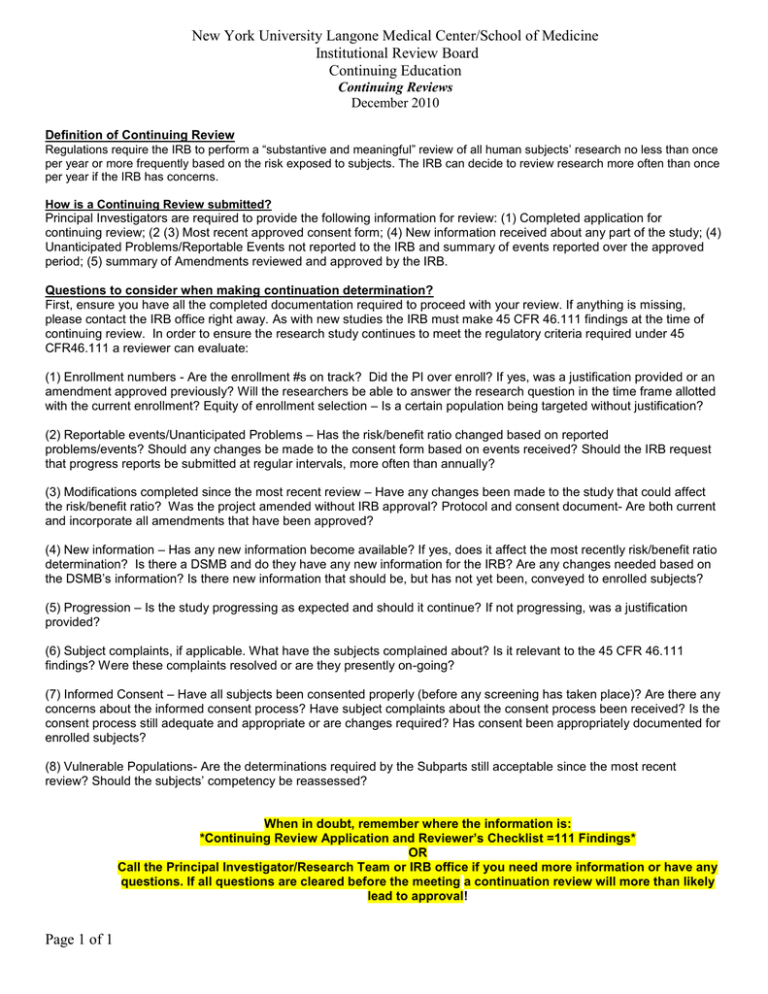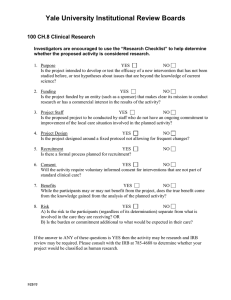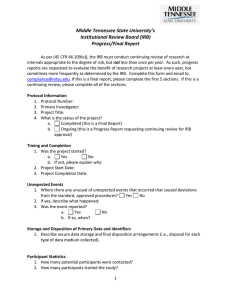December 2010: Continuing Reviews
advertisement

New York University Langone Medical Center/School of Medicine Institutional Review Board Continuing Education Continuing Reviews December 2010 Definition of Continuing Review Regulations require the IRB to perform a “substantive and meaningful” review of all human subjects’ research no less than once per year or more frequently based on the risk exposed to subjects. The IRB can decide to review research more often than once per year if the IRB has concerns. How is a Continuing Review submitted? Principal Investigators are required to provide the following information for review: (1) Completed application for continuing review; (2 (3) Most recent approved consent form; (4) New information received about any part of the study; (4) Unanticipated Problems/Reportable Events not reported to the IRB and summary of events reported over the approved period; (5) summary of Amendments reviewed and approved by the IRB. Questions to consider when making continuation determination? First, ensure you have all the completed documentation required to proceed with your review. If anything is missing, please contact the IRB office right away. As with new studies the IRB must make 45 CFR 46.111 findings at the time of continuing review. In order to ensure the research study continues to meet the regulatory criteria required under 45 CFR46.111 a reviewer can evaluate: (1) Enrollment numbers - Are the enrollment #s on track? Did the PI over enroll? If yes, was a justification provided or an amendment approved previously? Will the researchers be able to answer the research question in the time frame allotted with the current enrollment? Equity of enrollment selection – Is a certain population being targeted without justification? (2) Reportable events/Unanticipated Problems – Has the risk/benefit ratio changed based on reported problems/events? Should any changes be made to the consent form based on events received? Should the IRB request that progress reports be submitted at regular intervals, more often than annually? (3) Modifications completed since the most recent review – Have any changes been made to the study that could affect the risk/benefit ratio? Was the project amended without IRB approval? Protocol and consent document- Are both current and incorporate all amendments that have been approved? (4) New information – Has any new information become available? If yes, does it affect the most recently risk/benefit ratio determination? Is there a DSMB and do they have any new information for the IRB? Are any changes needed based on the DSMB’s information? Is there new information that should be, but has not yet been, conveyed to enrolled subjects? (5) Progression – Is the study progressing as expected and should it continue? If not progressing, was a justification provided? (6) Subject complaints, if applicable. What have the subjects complained about? Is it relevant to the 45 CFR 46.111 findings? Were these complaints resolved or are they presently on-going? (7) Informed Consent – Have all subjects been consented properly (before any screening has taken place)? Are there any concerns about the informed consent process? Have subject complaints about the consent process been received? Is the consent process still adequate and appropriate or are changes required? Has consent been appropriately documented for enrolled subjects? (8) Vulnerable Populations- Are the determinations required by the Subparts still acceptable since the most recent review? Should the subjects’ competency be reassessed? When in doubt, remember where the information is: *Continuing Review Application and Reviewer’s Checklist =111 Findings* OR Call the Principal Investigator/Research Team or IRB office if you need more information or have any questions. If all questions are cleared before the meeting a continuation review will more than likely lead to approval! Page 1 of 1


